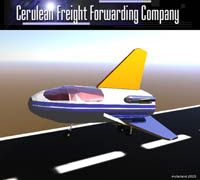 LUNAR’clips
LUNAR’clips
Livermore Unit of the National Association of Rocketry May/June 2002
Copyright © 2002 by LUNAR, All rights reserved.
Geoff Canham, LUNAR #
The Canadian Arrow is a rocket with the second stage doubling as an escape system. The second stage (crew cabin) is 20-ft. long and 5.4 ft. in diameter at the base, and contains four JATO type rocket engines for second stage propulsion. These solid rockets can be fired at anytime during the flight, including a launch pad abort.
The Canadian Arrow 54-ft long, two-stage, three person sub-orbital vehicle takes off vertically under 57,000 lbs of engine thrust. The first stage is 33.5 ft. long and 5.4 ft. in diameter with four fins at the base for aerodynamic stability. A single 57,000-lb thrust liquid propellant rocket engine burns for 55 seconds and propels the first stage to an altitude of 90,000 ft. The first stage propellants are fed to the engine using a pressurized gas system. This system is made up of two propellant tanks for fuel and oxidizer, topped by a single composite construction high-pressure gas sphere. Steering of the vehicle is accomplished using graphite jet vanes and aerodynamic flaps on the fins. The 20 ft long second stage crew cabin then separates and burns for 5 seconds, boosting the velocity enough to reach 70 miles altitude. The acceleration at separation is no more than 4.5 G's, achieved using four JATO type rocket engines. The pilot will orient the vehicle for the best window view for passengers during the flight through the 70-mile high arc. Just before re-entry the ram air ballute is deployed; once the crew cabin slows to subsonic speed the three main parachutes are pulled out slowing the vehicle to a gentle splashdown.

This rocket was displayed in New York City on April 24, 2002
Visit their Web site at www.canadianarrow.com
Cerulean Freight Forwarding Co.

The Cerulean craft taxis on a conventional runway about one mile long. Engines begin to hum as the tanks are pressurized and the brakes are released. The thrust is increased to yield a 2G acceleration - the equivalent of the acceleration experienced on a playground swing. At take-off, the vehicle is traveling at approximately 150 miles per hour and the nose is raised to 9 degrees above the horizon. At 40,000 ft. the Cerulean vehicle pitches to 75 degrees and accelerates at 2Gs for approximately 2 minutes. The craft then coasts for two minutes and pitches down to 60 degrees 2.5 minutes later. The Cerulean vehicle then begins a gliding descent to the port of origin for refueling and another trip. The entire flight lasts under two hours, with approximately 4.5 minutes of zero G, quick turnaround time allows for multiple flights in one day. The design will be optimized for the sub-orbital space tourism market place. The benchmark apex of flight of 62 miles (328,000 feet) is chosen as the U.S. Air Force's official definition of the boundary of space. More than half of the funds for development and testing of the Cerulean X PRIZE entry have been raised through private investors. The team anticipates launching within 18 months of achieving full funding.
Phase one (already begun) is the conceptual and preliminary design segment of the project. It will include theoretical design studies including cost analysis, preliminary blueprints, propulsion analysis, trajectory analysis, thermal engineering analysis, aerodynamic analysis, stress analysis, material selection, instrumentation selection, system integration plan, environmental impact studies and construction methodology. In addition market studies will be carried out to optimize design.
Phase two is a formal independent review of the design, characterization of construction technology, and feasibility of the project.
Phase three dependent upon the results of phase one and phase two. It will result in detailed design of sub-segments and individual components. A final review of all the project aspects including a detailed market report, environmental impact study, construction schedules, complete systems integration plan, and final blue prints.
Phase four is construction and testing of the experimental craft.
Visit their Web site at www.thriftyspace.com
Return to IndexAll content is the responsibility of LUNAR.
If you have comments or suggestions regarding these web pages,
please contact the 
Copyright © 1992 - 2025 LUNAR